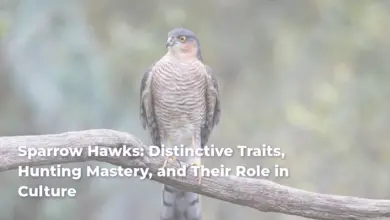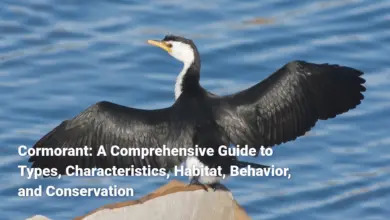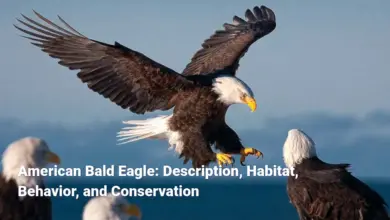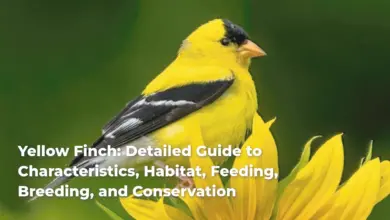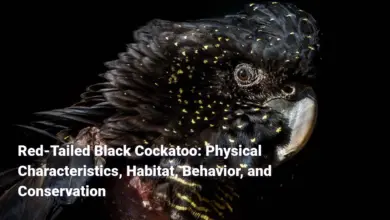Puffin Bird: A Comprehensive Guide to Species, Habitat, Behavior, and Conservation
Puffin Birds, often referred to as the “clowns of the sea” due to their colorful beaks and waddling gait, are mesmerizing seabirds that capture the imagination of bird enthusiasts and casual observers alike. Belonging to the Auk family, these birds are known for their striking plumage, engaging social behaviors, and unique adaptations to life both at sea and on rocky coastal cliffs. Found primarily in the North Pacific and North Atlantic Oceans, puffins exhibit a range of fascinating traits that not only underline their resilience and adaptability but also highlight the challenges they face in our ever-changing environment. Dive into the world of puffins as we explore their intriguing species, habitats, behaviors, diet, predators, and the concerted conservation efforts aimed at ensuring their survival.
Species of Puffin Birds
Puffins are represented by four distinct species: the Atlantic Puffin (Fratercula arctica), the Tufted Puffin (Fratercula cirrhata), the Horned Puffin (Fratercula corniculata), and the Rhinoceros Auklet (Cerorhinca monocerata). Each species showcases unique physical characteristics and behaviors that are adapted to their specific environments. The Atlantic Puffin, with its colorful bill, is perhaps the most iconic, while the Tufted Puffin is noted for its vibrant head plumes. The Horned Puffin stands out for the fleshy “horns” above its eyes, and the Rhinoceros Auklet, despite its name, is closely related to puffins and features a distinctive horn-like extension on its bill. These species, though sharing common traits, highlight the remarkable diversity within the puffin family.
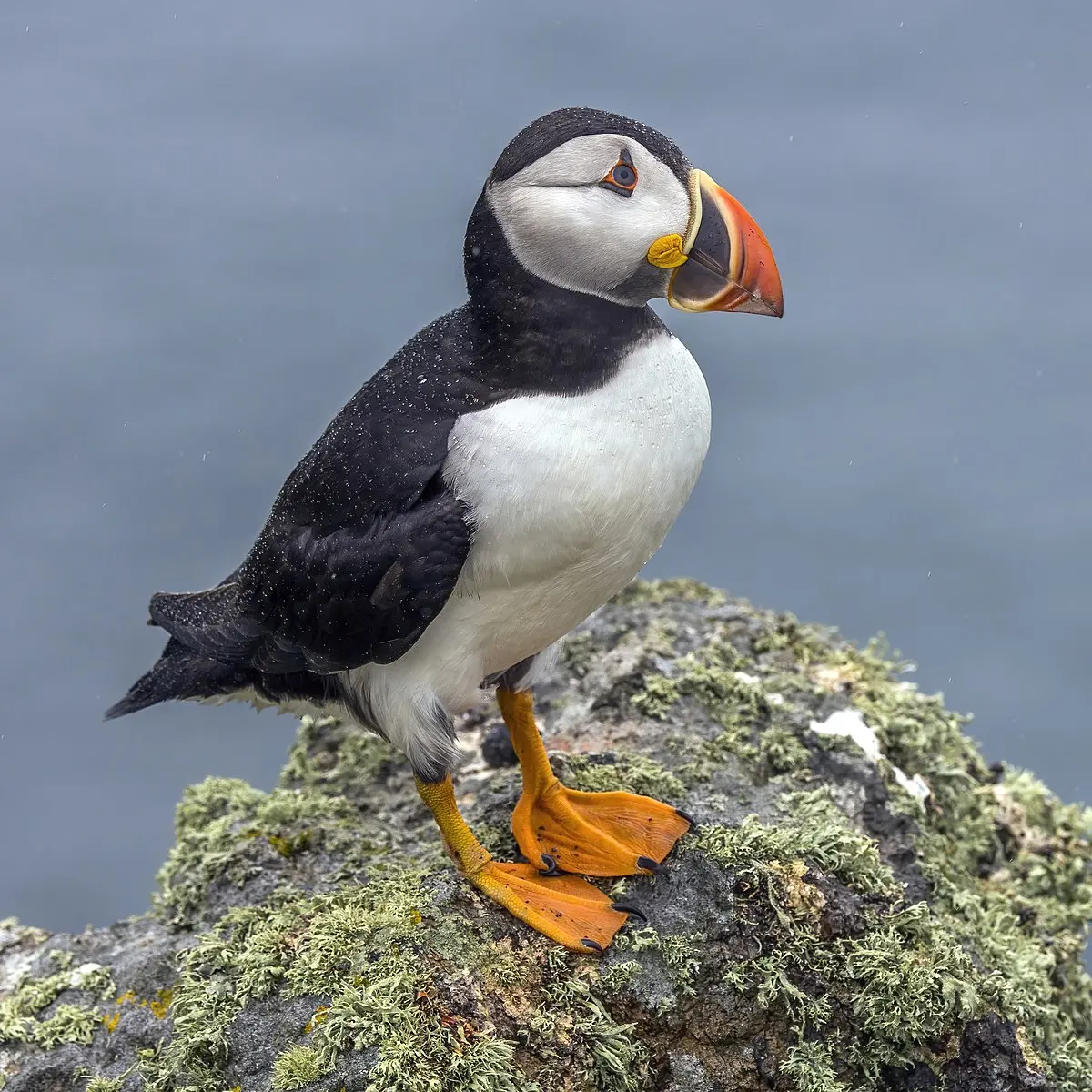
Atlantic Puffin Bird
The Atlantic Puffin (Fratercula arctica), often called the “common puffin,” is the only puffin species native to the Atlantic Ocean. This small seabird boasts a strikingly colorful bill that is as functional as it is beautiful. Measuring between 26 to 29 centimeters in length and weighing 310 to 550 grams, these birds are easily recognizable by their black and white plumage paired with a vivid bill that turns even more colorful during the breeding season. The transformation of their bill’s coloration, characterized by bright shades of orange, yellow, and black, is akin to nature’s own version of a peacock’s display. Outside the breeding season, their bill fades to a more subdued hue and reduces in size.
Puffin Birds breed on isolated islands and steep coastal cliffs scattered across the North Atlantic, from Iceland to the northeastern United States. Preferring rocky terrains with minimal terrestrial predator threats, they nest in burrows dug into the soil or tucked away among craggy rocks. These seabirds are also known for their exceptional diving ability, using their wings in a manner similar to penguins to navigate underwater and pursue small fish like herring and sand eels. Remarkably, they can dive to depths of about 60 meters (approximately 200 feet), although they typically stay submerged for only 20 to 30 seconds.
In terms of behavior, Atlantic Puffins exhibit a quiet demeanor while at sea but become considerably more vocal in their colonies. These social birds are generally gregarious during the breeding season, congregating in large colonies for nesting and engaging in various courtship rituals, such as “billing” – tapping their bills together in a rhythmic dance. Monogamous by nature, puffins usually form life-long pairs and often reuse the same nesting burrow each year. They breed once they reach the age of three to six, laying a single egg each season. The egg is incubated by both parents for 39 to 45 days, and the resulting chick, known as a “puffling,” is independent by 34 to 50 days of age.
The lifespan of an Atlantic Puffin can exceed 30 years, with some individuals living up to 41 years. However, they face numerous threats that have led to their classification as “Vulnerable” on the IUCN Red List. Factors like climate change, invasive predators, hunting, and habitat destruction continue to impact their populations, which are estimated to hold between 12 to 14 million mature individuals globally. Conservation efforts are vital to mitigate these threats and ensure the continued survival of this charismatic seabird.
Tufted Puffin
The Tufted Puffin (Fratercula cirrhata) stands out as the largest among puffin species, unmistakable due to its entirely black body contrasted with a bold white face and adorned with striking yellow tufts extending from its crown. This feature is particularly prominent during the breeding season, transforming these puffins into dazzling spectacles against the rugged backdrops of their nesting sites. Measuring up to 39 centimeters (15.4 inches) in length and weighing between 620 to 820 grams, Tufted Puffins cut an impressive figure. Outside the breeding season, their appearance becomes more subdued, with the bright white face turning ghostly gray and the vibrant tufts disappearing.
Tufted Puffins are typically found across the Pacific rim, stretching from the coasts of northern California to the Aleutian Islands in Alaska, and across to Japan and Russia. They exhibit a preference for breeding on offshore islands where they construct burrows in grassy turf. Unlike other puffin species, the Tufted Puffin digs relatively deep burrows, often measuring more than a meter, to protect their single egg from predators and the elements.
In flight, Tufted Puffins cut through the sky with remarkable speed, reaching up to 55 miles per hour. Their prowess isn’t limited to the air; they are adept divers, capable of plunging up to 200 feet beneath the water’s surface to catch fish. Their diet is diverse, including small fish such as herring and capelin, as well as squid and crustaceans. Remarkably, Tufted Puffins have the ability to hold many fish crosswise in their beak, thanks to a specialized hinge mechanism that allows the jaw to remain open while catching additional fish. This adaptation stands as a hallmark of their foraging efficiency.
Despite their adaptability, Tufted Puffins have seen notable population declines, particularly in the California Current Large Marine Ecosystem. Factors such as climate change, ocean pollution, and overfishing have led to dwindling numbers, especially along the coasts of Washington, Oregon, and California. Conservation status varies by region, with the species listed as endangered in Washington, sensitive in Oregon, and of special concern in California.
Conservation efforts for the Tufted Puffin include habitat protection, pollution mitigation, and sustainable fishing practices. Monitoring programs and community engagement projects aim to raise awareness and foster support for these birds. By understanding the unique needs and behaviors of the Tufted Puffin, conservationists hope to reverse the population decline and safeguard the future of this remarkable seabird.
Horned Puffin
The Horned Puffin (Fratercula corniculata) is another captivating member of the puffin family, distinguished by its striking black and white plumage and the characteristic fleshy “horns” above its eyes, which give the bird its name. These ornamental horns are prominent during the breeding season, adding to the bird’s unique and memorable appearance. Like their relatives, Horned Puffins have a colorful bill, with hues of orange, yellow, and white that stand out vividly against their contrasting body colors.
Horned Puffins inhabit areas around the North Pacific, where they are typically found from the Sea of Japan to the coasts of Alaska and as far south as British Columbia. Unlike the Atlantic Puffin, which prefers to nest in burrows, Horned Puffins often choose high cliff faces for their nests. These locations offer some protection from ground-based predators and provide an ideal launching point for their fishing excursions.
The behavior of Horned Puffins is characterized by their impressive diving capabilities. They are adept at diving to depths of over 100 feet, using their wings similar to flippers to pursue and catch fish. Horned Puffins primarily feed on small fish such as capelin, sand eels, and herring, and they have developed the unique ability to carry multiple fish at once in their beaks, making them efficient providers for their chicks during the breeding season.
During the non-breeding season, Horned Puffins spend most of their time at sea, where they are less vocal and more solitary compared to their time spent in densely populated colonies. Their return to land for breeding is marked by a series of courtship behaviors, including the aforementioned “billing” and various vocalizations meant to attract mates and establish territories.
Although the Horned Puffin is currently not considered endangered and is listed as a species of low concern, their populations still face threats from environmental changes and human activities. The stability of their populations is closely monitored to ensure any significant decline can be promptly addressed. Conservationists focus on protecting their nesting sites and ensuring a stable food supply by advocating for sustainable fishing practices and reducing pollution.
The Horned Puffin’s adaptability, striking appearance, and noteworthy behaviors make it a fascinating subject for birdwatchers and researchers. These seabirds play a crucial role in the ecosystems they inhabit, and understanding their life cycles and habits is key to ensuring their continued presence in the world’s oceans.
Rhinoceros Auklet
The Rhinoceros Auklet (Cerorhinca monocerata), despite its name, is a close relative of puffins and shares many of their characteristics. This seabird, notable for a distinctive horn-like protrusion on its orange bill during the breeding season, has a stout body covered in dark gray plumage with a paler underbelly. The white facial plumes that appear during breeding add to its unique look, making it a striking member of the auk family.
Rhinoceros Auklets are primarily found across the North Pacific region. Their range extends from the Channel Islands in California up through the Aleutian Islands in Alaska, and across to Hokkaidō and Honshū in Japan, the Korean Peninsula, and Sakhalin Island in Russia. These birds prefer coastal environments for breeding, often choosing rocky islands, cliffs, and natural caves for their nests. Rhinoceros Auklets usually dig their burrows between 1 to 5 meters deep, often in slightly inclined areas that facilitate easier takeoffs.
Feeding primarily on small fish, krill, and squid, the Rhinoceros Auklet demonstrates remarkable foraging behavior. During the breeding season, these birds typically feed closer to shore, diving to depths of up to 57 meters (187 feet) to catch their prey. An intriguing aspect of their behavior is their nocturnal feeding habit; they deliver food to their chicks mostly at night, likely an evolutionary adaptation to avoid predation by gulls and other opportunistic feeders.
The conservation status of the Rhinoceros Auklet is generally stable, although they do face similar threats as other seabirds, such as habitat loss, climate change, and pollution. Efforts to protect their breeding sites and manage fisheries sustainably are crucial for maintaining healthy populations.
The Rhinoceros Auklet is a fascinating example of a seabird with specialized habitat preferences, foraging techniques, and behaviors closely related to its puffin kin. Understanding these aspects of their life cycle aids in the conservation and appreciation of these remarkable birds.
Habitat
Puffin Birds thrive in coastal environments, predominantly in the North Atlantic and North Pacific Oceans. The preference for nesting in specific locales that offer safety from predators and access to abundant food supplies contributes significantly to their choice of habitat. Nesting sites are often steep, grassy cliffs or rocky islands that provide natural protection against land-based threats. These birds also demonstrate a striking degree of site fidelity, returning to the same nesting sites year after year.
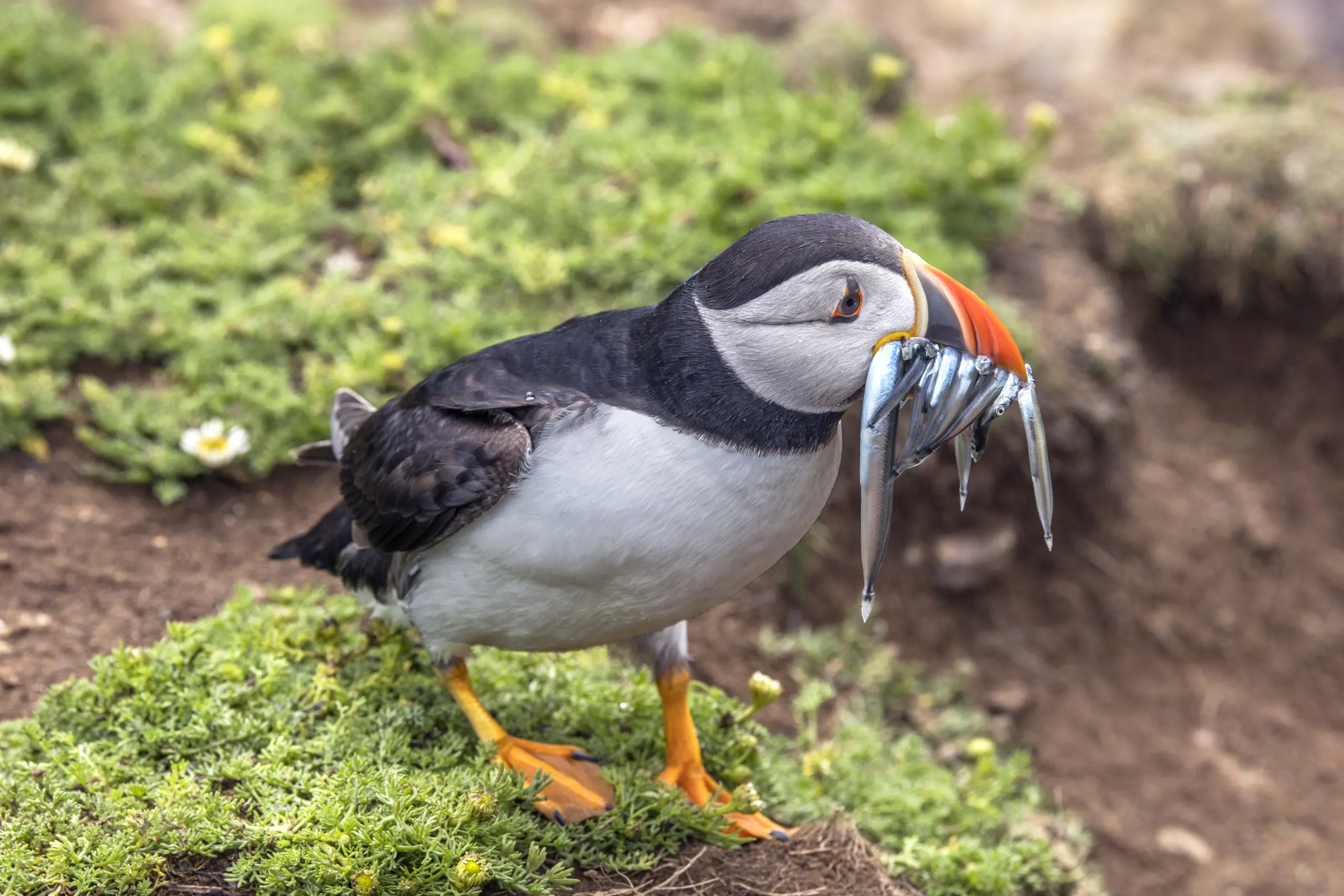
Nesting Sites
Nesting sites are vital for puffins, and they exhibit strong preferences when selecting these areas. One of the primary factors influencing their choice of nesting sites is safety. Puffin Birds favor steep, grassy cliffs or rocky islands that minimize the risk of predation from ground-based threats. These elevated and isolated locations help ensure that their eggs and chicks remain safe from predators like gulls, rats, and foxes.
Burrow nesting is a hallmark of puffin reproductive behavior, particularly for species like the Atlantic Puffin. They are skillful diggers, creating extensive burrows that can extend more than a meter into the ground. The burrows provide a microclimate that offers protection against harsh weather conditions and predators. Each nesting pair typically excavates a new burrow or returns to the same one each breeding season, demonstrating remarkable fidelity to their nesting sites.
In contrast, species like the Horned Puffin prefer high cliff faces, which offer the added advantage of being difficult for many predators to access. These cliff-side nests provide an ideal vantage point for adults to take off and land, making them suitable for raising chicks until they are ready to fledge.
Geographically, puffins’ nesting sites are spread across several regions. In North America, they breed on a few islands in the Gulf of Maine, including Eastern Egg Rock and Matinicus Rock. Canada boasts significant colonies along its eastern coast, from areas around Hudson Bay to Nova Scotia and New Brunswick. In Europe, puffins are common in the UK, nesting predominantly in the Northeast of England, Orkney Islands, North of Scotland, and the Isles of Scilly. Notably, Iceland is home to the world’s largest puffin colony on the Westman Islands, making it a critical habitat for these seabirds.
The selection of these nesting sites is a testament to puffins’ adaptability and their evolutionary strategies to maximize reproductive success. The burrows and cliff nests not only provide protection but also situate Puffin Birds in close proximity to rich feeding grounds, ensuring that they can efficiently provision their chicks during the breeding season.
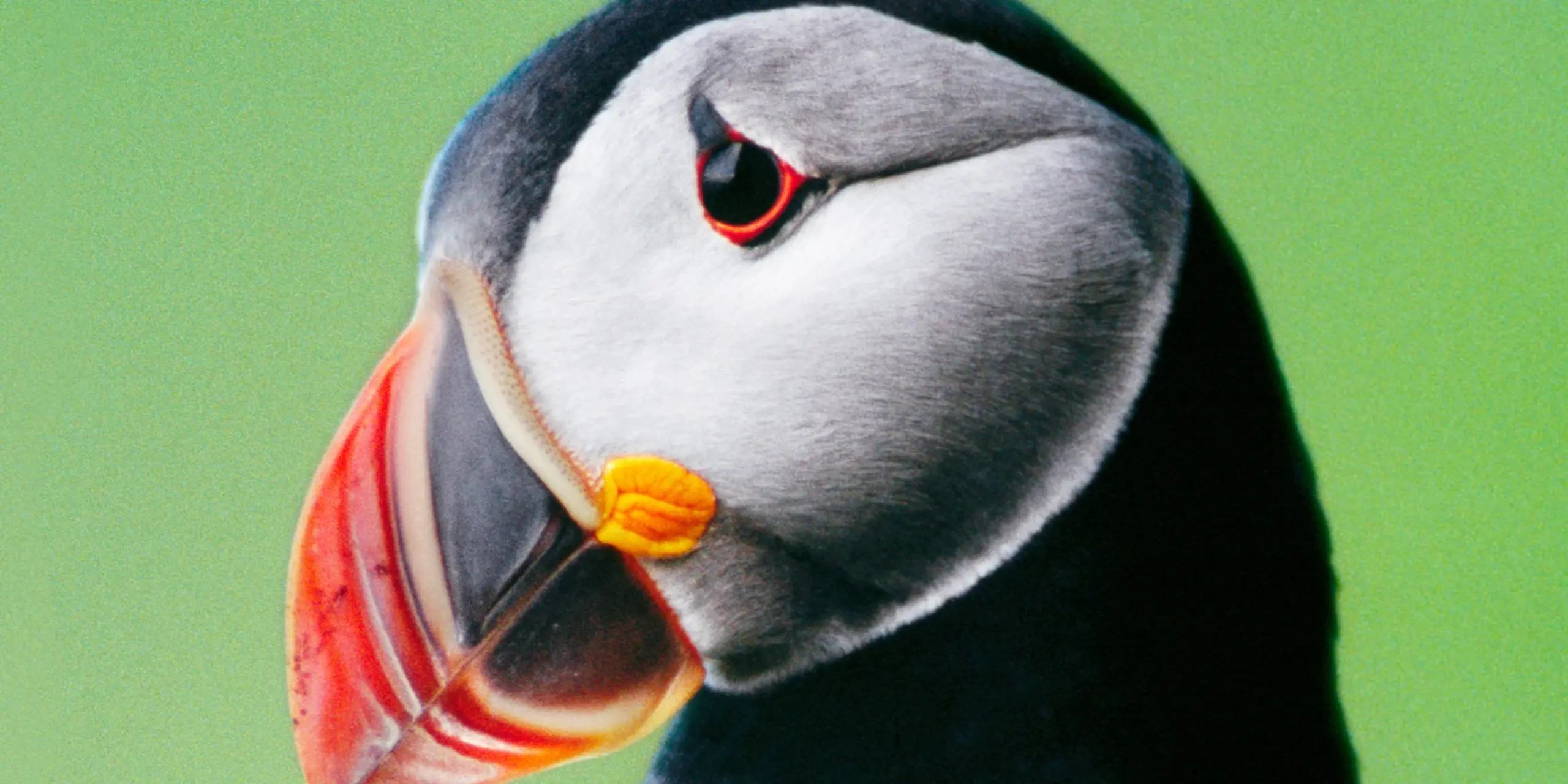
Geographic Distribution
The geographic distribution of Puffin Birds is remarkably widespread, encompassing various regions around the North Atlantic and North Pacific Oceans. This distribution is not only a testament to their adaptability but also reflects the diverse environmental conditions these birds have navigated throughout their evolutionary history.
North Atlantic Distribution:
- Eastern North America:
- Puffins breed on isolated islands and coastal cliffs off the coast of Maine, such as Eastern Egg Rock and Matinicus Rock.
- In Canada, they are found nesting from the regions around Hudson Bay down to Nova Scotia and New Brunswick.
- Europe:
- The UK hosts several significant colonies, particularly in the Northeast of England, Orkney Islands, North of Scotland, and the Isles of Scilly.
- Iceland stands out with the largest breeding colony located on the Westman Islands, housing millions of puffins.
North Pacific Distribution:
- North America:
- Puffins, particularly Horned and Tufted species, are found from northern California all the way to the Aleutian Islands in Alaska.
- They also extend into British Columbia.
- Asia:
- Their habitat includes parts of Japan, particularly Hokkaidō and Honshū.
- They are also found along the Korean Peninsula and the Russian island of Sakhalin.
During the non-breeding season, Puffin Birds disperse widely across the open ocean. This part of their life is still not fully understood, but telemetry studies have shown that they can travel thousands of kilometers away from their breeding sites. The Atlantic Puffin, for instance, may migrate from North Atlantic colonies to as far south as the waters off Spain and the Mediterranean.
These extensive migrations are driven by the search for food and suitable environmental conditions. The migratory routes and wintering grounds of puffins are critical for their survival, requiring adequate prey availability and favorable oceanographic conditions. The knowledge of these patterns is vital for their conservation, ensuring that protective measures are in place not only during the breeding season but throughout their life cycle.
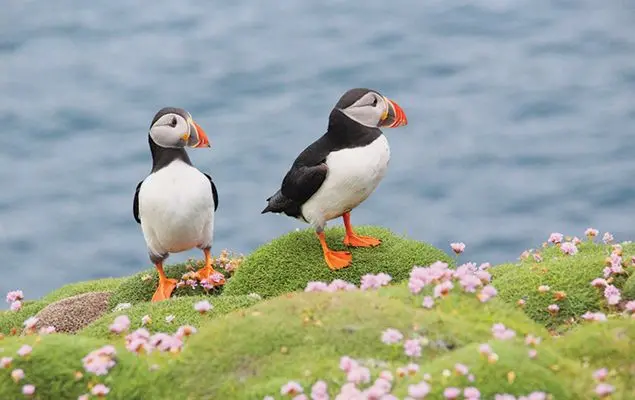
Understanding the geographic distribution of Puffin Birds helps highlight the importance of protecting their diverse habitats. Ensuring that these seabirds have access to safe nesting sites and abundant food resources across their expansive range is crucial for maintaining healthy populations.
Ideal Breeding Conditions
Ideal breeding conditions for Puffin Birds are characterized by specific environmental and behavioral factors that ensure the success of their reproductive efforts. These conditions include suitable nesting sites, social behaviors, and the timing of breeding activities.
Puffin Birds typically breed on steep, grassy cliffs or rocky islands with minimal terrestrial predators. These environments offer protection from ground-based threats such as rats and foxes. Nesting sites are chosen based on elevation and isolation, providing safety and an ideal microclimate for eggs and chicks. Puffins, particularly Atlantic Puffins, dig extensive burrows in these areas, creating insulated nests that shield their young from harsh weather conditions.
The social structure of Puffin Birds during the breeding season is highly collaborative. Puffins are known for their monogamous pair bonds and often return to the same nesting sites with the same mates each year. Courtship behaviors, such as head bobbing and bill clashing, play a crucial role in maintaining these bonds. These displays are often observed in the evenings when the colony is most active, contributing to an engaging and dynamic social environment.
Breeding seasons can vary depending on geographical location but generally occur during the spring and summer months. In regions like Iceland, puffins begin laying eggs as early as April, whereas in more temperate areas, breeding may start in June. This timing is closely aligned with the availability of food resources, ensuring that chicks hatch during periods of abundant prey.
Puffin Birds usually lay a single egg, which is incubated by both parents for about 39 to 45 days. The cooperation between both parents is essential, as they take turns foraging and incubating the egg. Once hatched, the chick, or “puffling,” is covered in down and becomes increasingly active, moving around the burrow. Parental care continues with both parents providing food, mainly small fish, to the growing chick.
The fledging period for pufflings ranges from 34 to 50 days, after which they make their way to the sea under the cover of darkness to avoid predators. This nocturnal departure is a survival strategy that ensures the young birds reach the ocean safely, where they will spend the next few years maturing before returning to breed.
The combination of protective nesting sites, strong pair bonds, timely breeding, and parental cooperation creates the ideal breeding conditions for puffins. These factors are vital for the reproductive success and long-term survival of puffin populations, underscoring the importance of preserving and protecting their natural habitats.
Behavior
Puffin Birds exhibit a range of behaviors that are essential for their survival and reproductive success. From social structures to feeding habits and migration patterns, these behaviors highlight their adaptability and intricate lifestyle.
Social Structure
Puffin Birds are highly social birds, particularly during the breeding season when they form large colonies on coastal cliffs and islands. The Atlantic Puffin (Fratercula arctica) is known for its gregarious nature, often engaging in communal activities such as courtship displays and nest building. These colonies are bustling hubs of activity, with puffins returning to the same burrows year after year.
Courtship displays are a prominent feature of puffin social behavior. “Billing,” where puffins rub their beaks together, is a common courtship ritual that not only strengthens pair bonds but also attracts potential mates. This behavior creates a spectacle for observers and reinforces the social cohesion within the colony.
The tufted puffin (Fratercula cirrhata) also exhibits unique social interactions during the breeding season. Vocalizations and physical displays are common, furthering social connections within the breeding colony. These interactions are crucial for maintaining the social structure and success of the colony.
Feeding Habits
Puffin Birds are carnivorous seabirds that primarily feed on small fish and zooplankton. Their diet includes species such as sandeels, herring, and capelin. Puffins have a specialized beak structure that allows them to hold multiple fish at once, thanks to a hinge mechanism that lets them keep their jaw open while catching additional fish. Thisadaptation is essential for transporting food back to their chicks during the breeding season. On average, puffins can carry up to 10-20 fish in their beaks at one time, with some extraordinary reports mentioning up to 60 fish, held securely by backward-pointing spines.
The feeding patterns of Puffin Birds are structured around the needs of their chicks. Observational data shows that puffins begin their feeding activities early in the morning, around 5:00 a.m., peaking between 5-7 a.m., and again in the evening from 6-8 p.m. This schedule ensures consistent nourishment for their young, who require up to 26 meals a day while growing. As the chicks approach fledging, the frequency of feedings decreases, aligning with their reduced dependency on parental provisions.
Puffins’ foraging behavior is influenced by environmental conditions. During harsh winters, they may struggle to find quality food, leading to a less nutritious diet and reduced survival rates. This adaptability to shifting marine ecosystems underscores the importance of monitoring environmental changes and ensuring sustainable fishing practices to support puffin populations.
Migration Patterns
Puffin Birds are primarily migratory birds, traveling extensive distances during the non-breeding season. After breeding concludes in late summer, puffins leave their coastal nests and migrate to open ocean areas where they spend the winter months. The migration routes of puffins are diverse and can span thousands of kilometers, with specific pathways influenced by oceanic conditions and prey availability.
For instance, Atlantic Puffins from northern populations may journey southward, traveling several thousand kilometers to locate food-rich waters. Telemetry studies have revealed that puffins can cover vast distances, with some individuals migrating from their breeding sites in the North Atlantic to as far south as the waters off Spain and the Mediterranean.
Diet plays a crucial role in dictating migration patterns. Puffin Birds primarily feed on small fish such as sand eels, herring, and capelin, and they exhibit remarkable diving capabilities, reaching depths of up to 60 meters (200 feet) to catch their prey. Their efficient foraging techniques allow them to hold multiple fish in their beaks simultaneously, thanks to their uniquely adapted beak structure.
To illustrate, research has indicated that the large-billed subspecies F. a. naumanni has distinct migration patterns, traveling different routes and distances compared to puffins from temperate regions. These differences are often driven by the availability of prey species like sand eels, which can vary significantly in distribution based on oceanographic conditions.
The migratory behavior of puffins is a testament to their resilience and adaptability. However, these long journeys also expose them to additional threats, such as changing marine environments, pollution, and accidental bycatch in fishing operations. Understanding and protecting their migratory routes is essential for ensuring the health and sustainability of puffin populations.
Diet
Puffin Birds are primarily carnivorous seabirds with a diet consisting mainly of small fish and other marine creatures. Their dietary preferences and foraging techniques are intricately tied to their habitat and seasonal availability of prey, which plays a pivotal role in their survival and reproductive success.
Types of Fish Consumed
Puffin Birds predominantly consume a variety of small fish species, which form the bulk of their diet. Some of the key species include:
- Herring: Abundant in their habitats, herring provides essential omega-3 fatty acids crucial for puffins’ health.
- Sand Eels: Often considered a staple food, sand eels are rich in protein and vital for feeding chicks during the breeding season.
- Capelin: Known as “rainbow smelt,” capelin are plentiful during breeding seasons and serves as an important food source.
- Other Fish: Depending on the region, puffins may also consume species like hake and sprat, adapting their diet to the available marine life.
Other Marine Creatures
In addition to fish, puffins’ diet includes a range of other marine organisms. These include:
- Squid: Offering vital nutrients, squid forms a significant part of their diet.
- Crustaceans: Including small shrimp, these are especially consumed during chick-rearing periods.
- Zooplankton: While not the primary food source, planktonic organisms occasionally supplement their diet.
- Marine Worms: Though less frequent, certain marine worms also add to the diversity of their dietary intake.
Foraging Techniques
Puffin Birds display highly specialized foraging techniques that enable them to thrive in their aquatic habitats. Their diving ability and unique beak adaptations are key to their successful hunting strategies.
Diving Ability
Puffin Birds are proficient divers, capable of reaching depths of up to 60 meters (200 feet) in pursuit of fish. They use a wing-flapping motion akin to flying underwater and maneuver with their feet to steer. This adaptation allows them to chase and capture prey efficiently in their underwater environment.
Efficient Fish Capture
Their beaks are adapted to carry multiple fish simultaneously, thanks to features such as serrated edges and a flexible jaw structure. Some individuals have been known to capture and manage up to 10 to 12 fish at a time. This ability to transport multiple prey items is crucial during the breeding season when feeding chicks.
Hunting Strategies
Puffin Birds often engage in numerous short dives while foraging, optimizing energy expenditure while maximizing their catch. During these dives, they prefer smaller fish, which are easier to catch and transport back to their nesting sites. Opportunistic feeding behaviors, such as stealing fish from other puffins, have also been observed, showcasing their adaptability in securing food.
Lifespan
The lifespan of Puffin Birds, particularly the Atlantic Puffin, can vary but generally averages around 20 to 30 years. Several factors influence their longevity, including survival rates during different life stages, environmental conditions, and threats from predators.
Factors Affecting Lifespan
The overall lifespan of puffins is affected by various intrinsic and extrinsic factors:
- Inherent Longevity: Puffins are long-lived birds, with records of individuals living up to 41 years. This longevity is indicative of their success in surviving harsh marine environments over extended periods.
- Environmental Conditions: Climate change, food availability, and extreme weather events can directly influence their lifespan by impacting their health and reproductive success.
- Predation Threats: Both juvenile and adult puffins face threats from predators, which can significantly reduce their survival rates.
Juvenile vs. Adult Survival Rates
The survival rates of juvenile and adult puffins differ markedly, with juveniles facing higher mortality risks:
- Juvenile Survival: Young puffins, or pufflings, experience significant dangers from the time they leave their nests until they return to the breeding grounds. The first few years are critical, with survival rates often lower than adults due to environmental pressures and challenges in finding food. Research indicates that traits such as wing length and mass at fledging are critical to their survival chances.
- Adult Survival Rates: Adult puffins generally exhibit higher survival rates, with probabilities averaging between 0.89 to 0.921. Once they reach maturity, their established ability to forage and navigate marine environments contributes to their longevity. Studies show that environmental conditions and food availability during the breeding season are crucial for sustaining their adult population.
Predators
Puffin Birds face a variety of predators both on land and at sea, which pose significant risks to their eggs, chicks, and adults. Understanding these threats is crucial for effective conservation strategies.
Land Predators
Land-based predators primarily target puffin eggs and chicks, significantly impacting their breeding success:
- Gulls: Larger gull species, such as the great black-backed gull, are notorious for preying on puffin nests. These birds often scavenge near colonies, waiting for opportunities to steal eggs and attack young chicks.
- Raptors: Birds of prey, including white-tailed eagles and peregrine falcons, pose a threat to puffins by capturing them in flight or on land during the breeding season.
- Introduced Mammals: Species such as rats and foxes, introduced to puffin nesting sites, have devastating effects by preying on eggs and young pufflings.
Sea Predators
While at sea, Puffin Birds face another set of predators:
- Larger Fish and Marine Mammals: Seals and sharks can prey on puffins when they are swimming near the surface of the water.
- Coastal Raptors: Birds of prey, such as white-tailed eagles, continue to be a threat even at sea, capable of catching puffins during flight or on the water’s surface.
Protective Behaviors
Puffin Birds have developed several protective behaviors to mitigate the risks posed by predators:
- Nesting Habits: Puffins nest in burrows dug into the soil on steep cliffs, making it difficult for many predators to access their eggs and chicks.
- Camouflage: Their black and white plumage provides a degree of camouflage, blending them into the ocean surface.
- Burrow Engineering: The depth and structure of their burrows offer significant protection, creating a safe haven during the breeding season.
- Vigilance and Colony Behavior: Nesting in large colonies increases vigilance, as more eyes can spot predators, allowing the colony to alert and protect one another.
- Quick Flight Responses: Puffins possess the ability to take swift flight when sensing danger, enabling them to escape terrestrial and aerial threats.
Conservation Status
The Atlantic Puffin and other puffin species face various conservation challenges, with their global populations reflecting differing levels of concern. Effective conservation strategies are essential to address the threats they encounter.
Threats to Puffin Populations
Puffin Birds face several significant threats that have led to population declines:
- Food Scarcity: Climate change and overfishing have disrupted marine ecosystems, resulting in the reduced availability of vital prey species such as sandeels and herring.
- Climate Change: Increasing frequency and intensity of extreme weather events prevent puffins from hunting effectively, causing mass mortalities in colonies.
- Pollution: Oil spills and plastic pollution degrade puffin habitats and affect their health through ingestion of contaminants.
- Introduced Predators: Non-native species, such as rats and foxes, invade nesting sites, preying on eggs and chicks.
- Human Disturbance: Hunting, tourism, and habitat disturbance can lead to breeding failures as puffins abandon nests due to human activities.
Conservation Efforts
Conservation efforts for Puffin Birds include habitat protection, sustainable fishing advocacy, and pollution mitigation:
- Habitat Protection: Ensuring that critical breeding and wintering habitats are protected from human disturbances and invasive species.
- Sustainable Fishing Practices: Promoting fishing practices that do not deplete key prey species, ensuring a stable food supply for puffins.
- Pollution Mitigation: Addressing pollution by controlling oil spills and reducing plastic waste in marine environments.
- Monitoring Programs: Implementing and supporting programs that monitor puffin populations and threats to inform conservation strategies.
- Public Awareness: Raising awareness about the importance of puffins and the challenges they face to garner public support for conservation initiatives.
Organizations Involved
Multiple organizations are actively involved in puffin conservation efforts:
- National Audubon Society: Leading various initiatives, including monitoring programs and public communication campaigns, to foster awareness and support for puffin conservation.
- U.S. Fish and Wildlife Service: Collaborating with partners to monitor and conserve puffins throughout their range.
- Friends of Haystack Rock: Engaging with local communities to support puffin conservation through education and advocacy programs.
- Seabird Institute: Coordinating conservation strategies and research programs to support puffin populations, particularly in regions facing critical declines.
Cultural Significance
Puffin Birds hold notable cultural significance and appear in various folklore narratives, serving as symbols in different cultures and contributing to local economies.
Puffin Birds in Folklore
Puffin Birds feature prominently in the folklore and cultural narratives of many coastal societies:
- Native American Significance: Among the Inuit and certain Native American tribes in coastal Alaska, puffins are seen as cultural symbols and believed to possess power over storms and weather. They play crucial roles in traditional regalia and clan identities.
- Celtic Symbolism: In Celtic mythology, puffins symbolize joy, happiness, duality, and balance, reflecting the harmony of nature and life’s contrasts. Their burrows represent a connection to earth and ancestry, underscoring reverence for heritage.
- Broader Mythology: In various mythological contexts, puffins symbolize communication, adaptability, and resilience. Their distinct beaks are emblematic of clear expression and truthful dialogue, playing roles as messengers or signs from deities.
Economic Importance
Puffin Birds contribute significantly to local economies, primarily through tourism and cultural identity:
- Tourism: Puffins attract birdwatchers and nature enthusiasts, boosting local businesses in regions like Iceland, Newfoundland, and the Faroe Islands.
- Cultural Identity: Puffin hunting and consumption have historical importance in some Indigenous Alaskan communities, though modern conservation efforts focus on sustainable practices and eco-tourism.
Symbolism in Different Cultures
Puffin Birds are revered symbols in various cultures, embodying values and connecting with spiritual narratives:
- General Symbolism: Representing adaptability, resilience, joy, and playfulness.
- Celtic Symbolism: Symbolizing duality, balance, and interconnectedness.
- Native American Symbolism: Serving as messengers and embodying communication and community ties.
- Christian Symbolism: Reflecting unity, resilience, and communal values.
- Eastern Cultural Significance: Resonating with themes of joy and mindfulness.
Interesting Facts
Puffins’ unique physical characteristics, vocalizations, and behaviors make them fascinating subjects of study and observation.
Unique Physical Characteristics
- Distinctive Beak: Colorful during the breeding season, adorned with bright orange, yellow, and red stripes.
- Compact Size: Measuring around 10 inches (25 centimeters) in length and weighing just over a pound.
- Specialized Swimming Ability: Using wings as flippers, capable of diving up to 200 feet.
- Colorful Plumage: Featuring a black back and wings, white belly, and gray wing feathers.
- Long Lifespan: Averaging over 30 years, with some living up to 41 years.
- Burrow Nesters: Digging burrows for nesting, providing protection from predators and harsh weather.
- Cultural Significance: Nicknamed “clowns of the sea” and attracting birdwatchers, contributing to coastal tourism industries.
- Unique Feeding Strategies: Capable of holding multiple fish at once with specially adapted beaks.
Vocalizations
Puffin Birds use a range of vocalizations to communicate, particularly during the breeding season. Their sounds include grunts, growls, and bill rattles, playing a role in attracting mates and communicating with partners and neighbors.
Fun Behaviors
Puffin Birds exhibit a variety of engaging behaviors:
- Billing: A courtship behavior involving beak rubbing to strengthen pair bonds.
- Nest Colonies: Nesting in large colonies, promoting social interaction.
- Aggressive Displays: Puffing up and gaping, revealing colorful beaks during confrontations.
- Fishing Technique: Using powerful flippers to catch and carry multiple fish.
- Long Lifespan: Living over 30 years, with extensive pre-breeding periods for maturity.
These captivating vocalizations and behaviors highlight puffins’ adaptability, social structures, and appeal to birdwatchers and nature enthusiasts.
Conclusion
Puffin Birds, with their vibrant appearances, unique behaviors, and cultural significance, are much more than just seabirds. They are a symbol of adaptability and resilience, navigating the challenges of their natural habitats both on land and at sea. Understanding and appreciating the complexities of their lives, from their intricate social structures and specialized feeding habits to their extensive migratory patterns and conservation status, provide valuable insights into the delicate balance of marine ecosystems. Continued conservation efforts and public awareness are crucial to ensure that puffins remain a vibrant and thriving part of our world’s biodiversity. Their survival is a testament to the beauty and interconnectedness of nature, reminding us of the importance of preserving these remarkable creatures for future generations.





